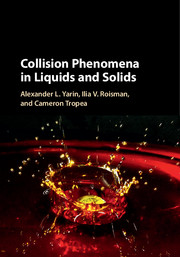Book contents
- Frontmatter
- Contents
- Preface
- 1 Introduction
- 2 Selected Basic Flows and Forces
- Part I Collision of Liquid Jets and Drops with a Dry Solid Wall
- Part II Drop Impacts onto Liquid Surfaces
- Part III Spray Formation and Impact onto Surfaces
- Part IV Collisions of Solid Bodies with Liquid
- Part V Solid–Solid Collisions
- Index
- References
2 - Selected Basic Flows and Forces
Published online by Cambridge University Press: 13 July 2017
- Frontmatter
- Contents
- Preface
- 1 Introduction
- 2 Selected Basic Flows and Forces
- Part I Collision of Liquid Jets and Drops with a Dry Solid Wall
- Part II Drop Impacts onto Liquid Surfaces
- Part III Spray Formation and Impact onto Surfaces
- Part IV Collisions of Solid Bodies with Liquid
- Part V Solid–Solid Collisions
- Index
- References
Summary
Penetration of solid bodies into liquids can be frequently treated in the framework of inviscid or potential flow hydrodynamics. In addition, collisions and penetration of solid bodies into solids in many cases, especially at the ordnance and ultra-ordnance velocities, can be effectively reduced to potential flows of ideal liquids possessing only inertia, since the stresses involved are significantly higher than the elastic and plastic stresses (see Section 1.1 in Chapter 1). Therefore, the present chapter is mostly devoted to several questions traditional to inviscid or potential flow hydrodynamics, which are either directly relevant in the context of collisions and penetration of solid bodies into liquids, or as simplified models useful for solid–solid collisions. Section 2.1 is devoted to the inviscid film flows on planar and curved surfaces. In the inertia-dominated regime characteristic of drop impact onto a thin liquid film on a wall, such flows give rise to kinematic discontinuities considered in Section 2.2 and associated with crown formation, which is considered in Section 6.7 in Chapter 6. The potential flow about an ovoid of Rankine discussed in Section 2.3 will be also employed in Chapter 13 in the case of projectile penetration into armor. The flow about an expanding and translating sphere outlined in Section 2.3 is also important in a purely hydrodynamic or rigid-projectile penetration context. Flows past axisymmetric bodies of revolution discussed in Section 2.4 are also important in the context of the projectile penetration. Transient motions of solid bodies in liquids inevitably involve deceleration associated with the added masses discussed in Section 2.5. A potential flow with separation about a blunt body (a plate moving normally to itself) is covered in Section 2.6 using the hodograph method of complex analysis to predict the shape drag. Friction drag associated with viscous effects is also discussed in Section 2.6. Finally, the dynamics of a rim bounding a free liquid film, for example a crown formed due to drop impact, is discussed in Section 2.7.
Information
- Type
- Chapter
- Information
- Collision Phenomena in Liquids and Solids , pp. 44 - 84Publisher: Cambridge University PressPrint publication year: 2017
